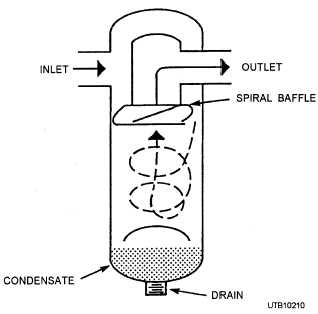a single bundle of tubes enclosed in a cylindrical shell. The air to be cooled passes through the tubes while the water circulates around the outside of the tubes absorbing the heat from' the compressed air. The baffles are used to direct the water flow across the heat exchanger tubes in the most efficient manner. The intercooler is located between the discharge of one cylinder and the intake of the next cylinder on a multistage compressor. The intercooler reduces the temperature and volume of the compressed air for delivery to the next compression stage. The aftercooler is located at the discharge of the last cylinder to cool the air, to reduce the volume, and to liquify any condensable vapors.
SEPARATORS. - Separators remove oil and water from compressed air. Figure 6-45 shows a centrifugal moisture separator. The air enters the unit in a swir ling motion. Centrifugal action forces the moisture to the walls of the separator and then the moisture drains to the bottom of the separator.
Another type of separator is the baffle type. This separator causes the air entering the separator to make sudden changes in direction, causing the heavier moisture particles to strike the baffles and walls and drain to the bottom.
TRAPS. - Compressor plant traps drain moisture from intercoolers, aftercoolers, receivers, and distribution piping. Common traps used are the ball float, the bucket, and the inverted bucket traps (fig. 6-46).
AIR RECEIVERS. - The receiver is nothing more than a tank designed to hold the -air that is compressed to meet supply peak demands that are in excess of the compressor capacity. Additionally, receivers function as pulsation dampers on reci- procating compressor installations. Figure 6-47 shows an air receiver.
DRYERS. - Dryers remove moisture from compressed air that would condense in air lines, air tools, and pneumatic instruments. Condensation can cause damage to equipment by corrosion, freezing, and water hammer, and will cause instruments to malfunction. The three types of dryers are adsorption, deliquescent, and refrigeration.
The adsorptive dryer is made of some type of desiccant, such as silica gel or activated alumina. The desiccant adsorbs and holds the water vapor from the air. Adsorption-type dryers (fig. 6-48) consist of two drying towers, each containing an adsorbent, plumed in parallel. The drying towers are cycled manually or automatically, so one tower is on stream and the other tower is being reactivated. Reactivation is accom- plished by heating the desiccant which drives the moisture out to waste.
Only one type of dryer was discussed in this chapter. Other types of dryers, maintenance, operation of controls, and other interesting information about compressors can be found in NAVFAC MO-206, Maintenance and Operation of Compressor Plants.
SAFETY PRECAUTIONS
Listed below are some safety tips on how you can avoid air compressor accidents.
Keep the hose connections on portable air compressors tight, and inspect these connections often to ensure they remain tight.
Check the safety valves and gauges frequently to make sure they are working correctly.
Use fixed tow bars, not chains or ropes, when moving portable air compressors.
Check the wheels of portable air compressor carriages to ensure proper operation.
When an air compressor is started, check the safety valves, the pressure controls, and the regulators to determine that they are working properly.
DO NOT leave the area of an operating compressor unless you are sure that the control,

Figure 6-45. - Centrifugal moisture separator.
Continue Reading